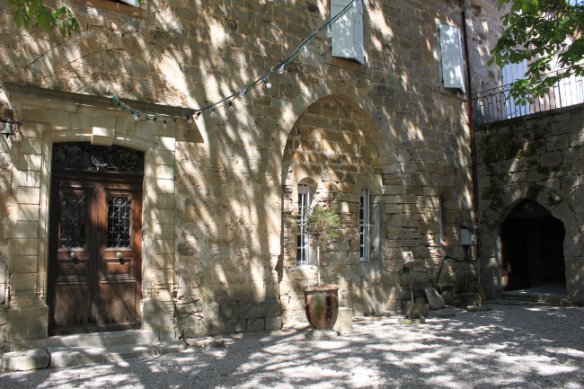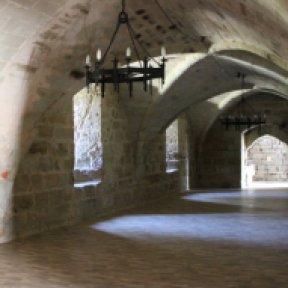Last week’s post was about the first half of a wonderful day out with friends in the hills near Lodeve. I’m going to continue the story with this post.
Following our delicious lunch at La Petite Fringale in Saint Jean de la Blaquiere, we drove towards Lodeve, to visit the Priory of Saint Michel de Grandmont. This monastery belonged to the little known order of Grandmont, an order founded at the end of the 11th or the beginning of the 12th century, according to which historian you believe. The rules of the order were incredibly austere, even for mediaeval times: possessions were forbidden, heating was only for visitors, monks walked barefoot all year round and lived in strict silence. Their lives were more like those of hermits, even though they lived in communities. Lay brothers were an integral part of each monastery – they had to look after the day-to-day running of the monastery.
The set of buildings at Saint Michel de Grandmont is one of the few Grandmontine houses left more or less intact.
 The entire order was dissolved in 1772 due to lack of monks, and the monastery was attached to the diocese of Lodeve. The last monks left Saint Michel de Grandmont in 1785.
The entire order was dissolved in 1772 due to lack of monks, and the monastery was attached to the diocese of Lodeve. The last monks left Saint Michel de Grandmont in 1785.
During the French revolution the buildings were sold, but lucky for us, they were not demolished, and not hugely altered either. The picture above shows the buildings overlooking the courtyard – you can see part of the gable end of the church on the left.
The audio guide (available in several languages, including English) which was part of the entrance fee was very helpful! The visit started in the visitors’ room, a sturdy vaulted room with an enormous fireplace, where visitors to the monastery were welcomed. This fireplace was the only one in the monastery, as physical comforts were a no-no for the monks.
A wooden model showed the cloister, with the vaulted chapter house area on the ground floor and the monks’ dormitory above.
The double doors at the end of the visitors’ room led to a small, dark room, and from there a door led to the cloister. The cloister is supposed to be the only one of all the Grandmontine cloisters to be remaining intact. The architecture is very simple and austere!
A doorway led from the cloister to the church. In the time of the monks, there would have been some ecclesiastical furniture, but today the church’s walls are bare and the building is almost completely empty. The proportions of the church were impressive – 28 metres long, 6.7metres wide and 11 metres high! The acoustics were wonderful, and during the summer season concerts are being held in the church on a regular basis.

 The chapter house was just off the cloister – a large vaulted room with arrow slit windows on one side. The chapter house was the place where the monks gathered every day, to listen to the rules of the order being read, and to do penance.
The chapter house was just off the cloister – a large vaulted room with arrow slit windows on one side. The chapter house was the place where the monks gathered every day, to listen to the rules of the order being read, and to do penance.
From the chapter house, we stepped out into the sunshine. The guided walk took us around the back of the chapter house and to the apse of the church. I got the feeling that the mullioned windows above the arrow slits of the chapter house were a later addition.
By the apse of the church, excavations had revealed the remains of Visigothic tombs.
The audio guide took us back to where we had exited the chapter house – a terrace shaded by chestnut trees. The facade of the building along the terrace had been remodelled in the 18th century and given a more classical look with a pedimented door and other architectural elements (not visible in the picture below).
 Our walk continued to the park, across another terrace, this one planted with plane trees, which had not yet leafed out.
Our walk continued to the park, across another terrace, this one planted with plane trees, which had not yet leafed out.
 A little climb brought us to a rather surprising feature – an ornamental lake with an island in the middle! The plinth bore an inscription in Latin and a date of 1850. At that time Etienne Vitalis was the owner of the property. The audio guide explained that the lake was created where the stone for the monastic buildings had been quarried. The lake is fed by a small stream and the water was no doubt used to irrigate fields and gardens.
A little climb brought us to a rather surprising feature – an ornamental lake with an island in the middle! The plinth bore an inscription in Latin and a date of 1850. At that time Etienne Vitalis was the owner of the property. The audio guide explained that the lake was created where the stone for the monastic buildings had been quarried. The lake is fed by a small stream and the water was no doubt used to irrigate fields and gardens.
 On we went, through the woodland surrounding the lake, to the next point of interest: vestiges of pre-historic man’s occupation of the site!
On we went, through the woodland surrounding the lake, to the next point of interest: vestiges of pre-historic man’s occupation of the site!
The views from there were spectacular!
After a brief walk, we reached a dolmen, the final point of our guided visit. It sits all by itself and the views from there were also spectacular! Legend has it that the monks used to sit inside the dolmen to be healed when they were sick!
On our way back to the abbey, there was a lovely view of the buildings across a green field:
The priory of Saint Michel de Grandmont is open from February to the end of December, from 10am to 6pm. It is closed on Mondays during the off-season. Full details can be found on www.prieure-grandmont.fr
I leave you with a video of the fountain which plays on the courtyard wall. It sums up the peace and serenity of Saint Michel de Grandmont on the day that I visited.



























Grateful for those who preserve historical treasures.
LikeLiked by 1 person
Thank you Inese – great to see you’re back on-line again!!
LikeLiked by 1 person
Thank you 🙂
LikeLiked by 1 person